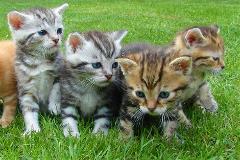Congenital Defects Observed in Newborn Kittens

While not as common in kittens, congenital birth defects can cause cosmetic abnormalities, physical impairments, and, sometimes, death. When considering a kitten for adoption or when awaiting the birth of a litter, clients may benefit from the following information.
The following congenital defects may be notably obvious in newborn kittens at birth.
Congenital Defects in Kittens
Cleft Palate and Harelip
A congenital physical birth defect involving the nasal and oral cavities that makes it very difficult for a kitten to nurse normally. When severe, the kitten’s survival is usually dependent upon tube feedings.
- Two types:
- Primary cleft palate, cleft lip, or harelip:
- Caused by abnormal development of the upper lip
- Observable signs:
- One nostril may be misshapen
- Gums of the upper jaw may be visible
- Secondary cleft palate:
- Caused when the palate bones fail to develop and fuse, creating an opening that form along the roof of the mouth
- Observable signs may include:
- Sneezing and snorting as food and saliva pass into the nose
- After nursing or eating, the animal will have a runny nose
- If the opening becomes infected, the kitten’s nose will run constantly
- Animal may cough and gag
- Extra fluid or nose infections causes low energy levels and breathing difficulties
- Eating difficulties cause a slow rate of growth
- These defects occur more commonly in purebred breeds, with a higher incidence observed in Siamese kittens
- The main cause is genetics, but the risk to kittens may be increased when the queen is affected by nutritional deficiencies, viruses, or poisons during pregnancy
- Treatment:
- Can be corrected by surgery
- Risk of complications are fairly high
- Aftercare may be extensive.
Hernia
Also a hereditary birth defect, a hernia occurs as a result of a developmentally delayed closure of the abdominal ring.
- Two types:
- Umbilical hernia:
- The most common type to affect a kitten, is typically observed around the time the animal reaches 2 weeks of age
- Usually begins to decrease in size, disappearing by the time the kitten reaches 6 months of age
- Inguinal hernia:
- Usually observed in a female, but not typically seen until they are mature or bred, the bulge will be observed in the cat’s groin
- Hernias are classified by the terms:
- Reducible: whether the hernia bulge can be pushed back into the animal’s abdomen
- Incarcerated hernia: When the hernia bulge can’t be pushed back into the abdomen
- Treatment:
- Most umbilical hernias disappear before the cat reaches 6 months of age
- Umbilical hernias that do not get smaller, but remain or increase in size, will need to be surgically repaired
- Inguinal hernias
- Can become strangulated if the blood supply that goes to the tissues is pinched
- If the swelling becomes painful and hard, it is an indication of an incarcerated hernia and the animal needs emergency help
- Require surgery to repair the defect.
Pyloric Stenosis
A congenital defect that narrows the pyloric canal and results in a kitten’s inability to pass food out of its stomach.
- Pyloric stenosis occurs at the area where the stomach opens to the small intestines
- When the muscles that open the stomach thicken, the enlargement causes the opening to narrow which prevents food from passing out of the stomach and into the intestines
- Most commonly detected in the Siamese breed, and in animals that are related
- Observable signs include:
- Several hours after eating, kitten will vomit partially digested food, but there will be no bile within the vomit
- Some kittens will not begin showing signs until closer to weaning, occurring after they have been started on solid food
- Diagnosis usually requires completion of an ultrasound or an upper gastrointestinal x-ray
- Treatment:
- Best type of treatment requires veterinarian input, which may involve:
- Dietary management
- Surgical division of the opening ring which will allow food to pass out of the kitten’s stomach.
While certain congenital defects may require a lifetime of care, the availability of treatment options will help to maintain an animal’s high quality of life. Clients interested in raising kittens diagnosed with congenital defects will benefit from discussing concerns with their veterinarian.
For additional information to pass on to clients about what it takes to raise a healthy kitten, please contact your Covetrus representative at 855.724.3461.
Sources:https://www.acvs.org/small-animal/cleft-palate
http://www.petmd.com/cat/conditions/mouth/c_ct_cleft_palate%20
Need Regulatory Assistance
If you need help with regulatory or licensing issues, we're happy to help. We have a wide variety of resources to help you when issues arise.

Careers
Are you looking for a place to let your talents shine? At Covetrus, we help our practitioner customers better serve their patients and take pride in providing the best customer experience possible. Search our open positions to see our available opportunities.
Newsletter
Stay current with what’s going on with Covetrus, subscribe to receive our newsletter and email communications. Subscribers will receive the latest information in practice management, sales and marketing, animal health, and more.


Leave a comment